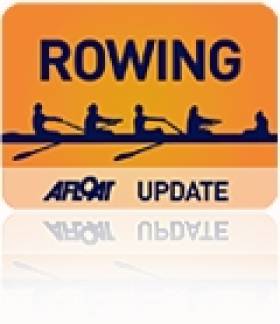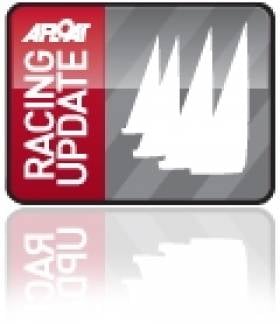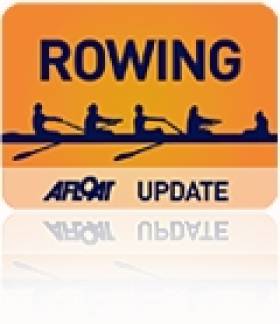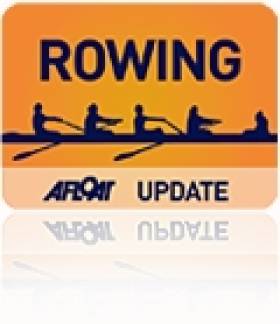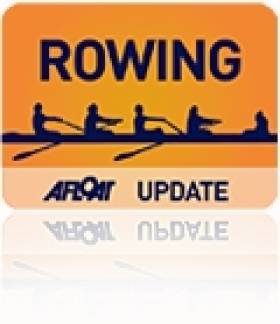Displaying items by tag: Lucerne
Puspure Progresses as Crow Flies at Lucerne Rowing
#ROWING: Sanita Puspure qualified for the semi-finals of the World Cup regatta in Lucerne today with a steady second place in her heat. Kim Crow of Australia was the clear winner, but Puspure slotted into the only other qualification spot early on and held off a challenge by Italy’s Sara Magnaghi.
The Ireland women’s pair found it tougher in their heat. Britain’s Helen Glover and Heather Stanning won and took the one qualifying spot. Ireland finished fifth.
World Cup Regatta, Lucerne, Day One (Selected Results, Irish interest)
Women
Pair – Heat Two (Winner directly to A Final; rest to Repechage): 1 Britain (H Glover, H Stanning) 7:13.07; 2 New Zealand 7:16.01,3
Netherlands 7:26.54, 4 Australia 7:32.52, 5 Ireland (L Kennedy, L Dilleen) 7:40.89, 6 Czech Republic 7:46.63.
Single Sculls – Heat One (First Two Directly to A/B Semi-Final; rest to Repechage): 1 Australia (K Crow) 7:39.88, 2 Ireland (S Puspure) 7:45.55; 3 Italy 7:52.04, 4 Lithuania 7:58.75, 5 Serbia 8:07.62.
Puspure Takes Second Successive Rower of the Month Award
#ROWING: The Rower of the Month for June is Sanita Puspure. The single sculler from the Old Collegians club won her place in the A Final of the World Cup at Aiguebelette in France, where she finished sixth. It was confirmation that the Latvian-born competitor who now lives in Cork has established herself in this demanding discipline. She will compete in the final World Cup of the season, in Lucerne in Switzerland, next weekend.
The Ireland Olympian wins the award for the second successive month, having also taken it in May, when she took bronze at the European Championships.
Rower of the Month awards: The judging panel is made up of Liam Gorman, rowing correspondent of The Irish Times and David O'Brien, Editor of Afloat magazine. Monthly awards for achievements during the year will appear on afloat.ie and the overall national award will be presented to the person or crew who, in the judges' opinion, achieved the most notable results in, or made the most significant contribution to rowing during 2014. Keep a monthly eye on progress and watch our 2014 champions list grow.
Racing Round up: Dun Laoghaire Regatta, ISAF Youths, Optimists, Paralympic, RORC, WIORA, Quarter Ton, Kiteboarding.
In offshore news, the Transatlantic Race 2011 Nears a Finish, and RORC yachts that headed West did best in the St Malo from Cowes race. Ireland's entry in the Tall Ships race, Celtic Mist, is safely in Scotland. WIORA starts this week in Clifden, thirty boats are expected.
Two top Cork performers are in Cowes for this week's Quarter Ton Cup.
In other boating news, rower Siobhan McCrohan won bronze at the World Rowing Champs in Lucerne, Kiteboarding debuted in Dun Laoghaire. There were Medals for Irish Kayakers at Athens Special Olympics.
And finally after a Elaine 'Shooter' Alexander is set for hero's welcome this week as she becomes the first woman from Northern Ireland to circumnavigate the island of Ireland.
All on our home page this morning, thanks for your interest in Irish Sailing and Boating.
Ireland Women's Double Finishes Eleventh at World Cup
Ireland’s Lisa Dilleen and Sanita Puspure finished fifth in the B Final of the women’s double scull at the World Cup rowing regatta in Lucerne. This places the Irish 11th overall. Belarus and the United States were the two top crews down the course with Belarus striking for the finish first and taking first. The race featured four of the crews which competed in the A Final at Munich, where Dilleen and Puspure also finished fifth.
World Cup Regatta, Lucerne – Day Three (Irish interest)
Women
Double Scull – B Final (Places 7 to 12): 1 Belarus 7:03.19, 2 United States 7:04.44, 3 Italy 7:08.71, 4 Romania 7:09.08, 5 Ireland 7:10.29, 6 China 7:14.83.
McCrohan Wins Bronze Medal at World Cup Rowing Regatta
Irish rowing got a real fillip today when lightweight single sculler Siobhan McCrohan won a bronze medal at the World Cup rowing regatta at Lucerne. In a race won by the outstanding Greek talent Alexandra Tsiavou, the 24-year-old Galway woman saw off challenges from Belgium’s Jo Hammond and Poland’s Weronika Deresz to take bronze. Switzerland’s Pamela Weisshaupt took the silver medal.
World Cup Regatta, Lucerne – Day Two (Irish interest)
Men
Lightweight Double Scull – D Final (places 19 to 24): 1 Hungary 6:36.15, 2 Ireland 6:43.77, 3 Sweden 6:44.75.
Women
Double Scull – Semi-Final (First Three to A Final; rest to B Final): 1 Australia 6:54.22, 2 Ukraine 6:56.73, 3 Poland 6:58.30; 4 Belarus 7:07.73, 5 Romania 7:09.95, 6 Ireland (L Dilleen, S Puspure) 7:15.75
Lightweight Double Scull – C Final (Places 13 to 18): 1 Austria 7:14.01; 5 Ireland (S Dolan, C Lambe) 7:19.47
Lightweight Single Scull – Semi-Final One (First Three to A Final; rest to B Final): 1 Switzerland (P Weisshaupt) 7:56.1, 2 Ireland (S McCrohan) 7:58.65, 3 Belgium (J Hammond) 8:03.22; 4 Japan 8:09.31, 5 Canada 8:09.80, 6 Hong Kong 8:14.50. A FINAL: 1 Greece (A Tsiavou) 7:47.78, 2 Switzerland (P Weisshaupt) 7:51.39, 3 Ireland (S McCrohan) 7:54.86; 4 Belgium (J Hammond) 7:55.17, 5 Poland (W Deresz) 7:59.80, 6 Netherlands (M-A Frenken) 8:02.57.
Dilleen and Puspure Hit by Poor Start in Lucerne
Ireland’s women’s double of Lisa Dilleen and Sanita Puspure have had to settle for a place in the B Final at the World Cup rowing championships in Lucerne. In their semi-final they missed strokes after catching a buoy near the start and were never contenders for one of the top three places which would have sent them into the A Final.
World Cup Regatta, Lucerne – Day Two (Irish interest)
Men
Lightweight Double Scull – D Final (places 19 to 24): 1 Hungary 6:36.15, 2 Ireland 6:43.77, 3 Sweden 6:44.75.
Women
Double Scull – Semi-Final (First Three to A Final; rest to B Final): 1 Australia 6:54.22, 2 Ukraine 6:56.73, 3 Poland 6:58.30; 4 Belarus 7:07.73, 5 Romania 7:09.95, 6 Ireland (L Dilleen, S Puspure) 7:15.75
Lightweight Double Scull – C Final (Places 13 to 18): 1 Austria 7:14.01; 5 Ireland (S Dolan, C Lambe) 7:19.47
Lightweight Single Scull – Semi-Final One (First Three to A Final; rest to B Final): 1 Switzerland (P Weisshaupt) 7:56.1, 2 Ireland (S McCrohan) 7:58.65, 3 Belgium (J Hammond) 8:03.22; 4 Japan 8:09.31, 5 Canada 8:09.80, 6 Hong Kong 8:14.50.
Maher and O'Donovan Finish Well at Lucerne
The Ireland lightweight double scull of Michael Maher and Mark O’Donovan held off Sweden to take second place in the D Final and 20th place overall at the World Cup rowing regatta in Lucerne. Hungary’s Tamas Varga and Peter Galambos were runaway winners. A huge entry of twenty-nine crews started in this event.
Sarah Dolan and Claire Lambe, the Ireland women’s lightweight double, finished fifth in their C Final, placing them 17th of the 24 crews competing.
World Cup Regatta, Lucerne – Day Two (Irish interest)
Men
Lightweight Double Scull – D Final (places 19 to 24): 1 Hungary 6:36.15, 2 Ireland 6:43.77, 3 Sweden 6:44.75.
Women
Lightweight Double Scull – C Final (Places 13 to 18): 1 Austria 7:14.01; 5 Ireland (S Dolan, C Lambe) 7:19.47
Lightweight Single Scull – Semi-Final One (First Three to A Final; rest to B Final): 1 Switzerland (P Weisshaupt) 7:56.1, 2 Ireland (S McCrohan) 7:58.65, 3 Belgium (J Hammond) 8:03.22; 4 Japan 8:09.31, 5 Canada 8:09.80, 6 Hong Kong 8:14.50.
McCrohan Guarantees A Final Spot at Lucerne
Siobhan McCrohan qualified for the final of the lightweight single scull at the World Cup rowing regatta at Lucerne in Switzerland by taking second in her semi-final. The goal of a top three place was annexed early and not yielded up: she was in second behind Pamela Weisshaupt, the world champion in 2008 and 2009 all the way down the course. Jo Hammond, a Briton who now rows for Belgium, took third.
World Cup Regatta, Lucerne – Day Two (Irish interest)
Women
Lightweight Single Scull – Semi-Final One (First Three to A Final; rest to B Final): 1 Switzerland (P Weisshaupt) 7:56.1, 2 Ireland (S McCrohan) 7:58.65, 3 Belgium (J Hammond) 8:03.22; 4 Japan 8:09.31, 5 Canada 8:09.80, 6 Hong Kong 8:14.50.


























